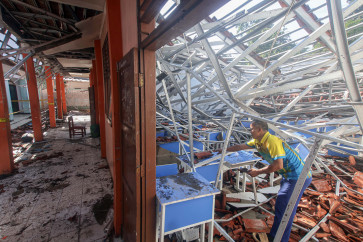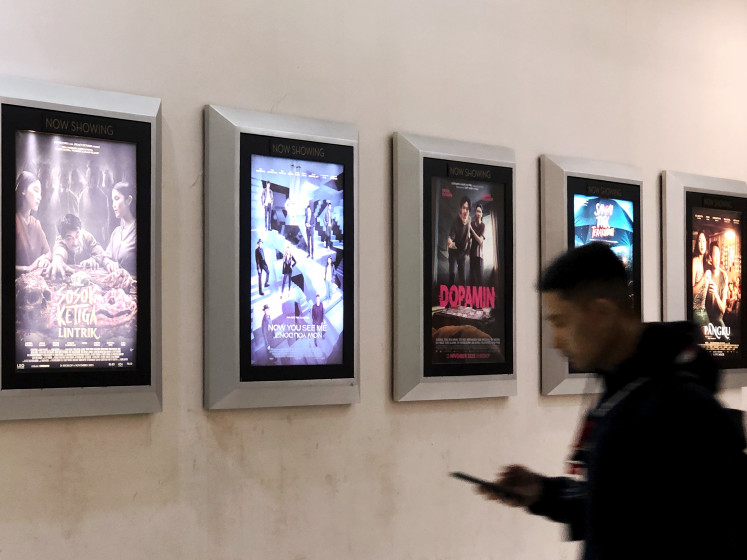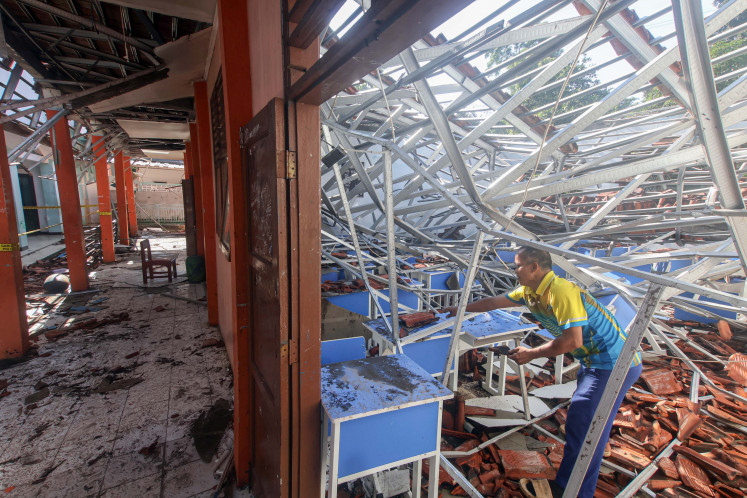Popular Reads
Top Results
Can't find what you're looking for?
View all search resultsPopular Reads
Top Results
Can't find what you're looking for?
View all search resultsTiga Dara Restoring with a mission
Herculean effort: Lisabona Rahman (left to right), Taufiq Marhaban, Lintang Gitomartoyo and Alex Sihar share their experience in the restoration of the 1956 classic Tiga Dara film at Kinosaurus in Aksara bookstore in South Jakarta
Change text size
Gift Premium Articles
to Anyone
A
team behind the restoration of Usmar Ismail’s masterpiece film Tiga Dara reveals the hard work that they put in to save a national legacy.
SA Films executive producer Alex Sihar was all smiles when talking about people’s appreciation for the restored version of late director Usmar Ismail’s musical drama Tiga Dara (Three Girls) after it hit theaters on Aug. 11.
Cinemas playing the restored film of Tiga Dara attracted unusual groups of moviegoers, some of which consisted of beautiful, dressed up grandmothers accompanied by their children.
By the end of August, the film had lured 26,373 viewers in total, which Alex said was a mind-blowing number because the total number of viewers of the restored version of the 1954 classic Lewat Djam Malam (After the Curfew), another Usmar masterpiece, had been around 5,000 in 2012.
First released in 1956, Tiga Dara tells the story of three sisters, namely Nunung (Chitra Dewi), Nana (Mieke Wijaya) and Neni (Indriati Iskak) as well as their restless grandmother (Fifi Young), who desperately wants to see Nunung get married. The film was a smash hit, a commercial success that attracted a massive audience back then and became a pop icon of the era.
Tiga Dara was the first film to be restored in the 4K resolution format, a key part of digital cinema that allows us to enjoy better pictures and thereby a greater viewing experience in theaters.
However, restoring the film cost around US$260,000, leading to the question of whether the current enthusiasm for the film in the theaters and the resulting capital return was worth the cost. Alex gave a short, realistic answer.
“Not yet. There should be at least 200,000 viewers [to recoup the investment]. But we understand it will be very difficult reach that number,” he said during a discussion attended by four filmmakers participating in the project — Lintang Gitomartoyo, Lisabona Rahman, Taufiq Marhaban and Benjamin Windra.
Therefore, his company produced Ini Kisah Tiga Dara (This is the Story of Three Girls), inspired by the classic Tiga Dara, for which he teamed up with director Nia Dinata of Kalyana Shira Films.
Alex hoped that ticket sales for Ini Kisah Tiga Dara, which premiered early this month, would help cover the remaining cost of restoring the classic Tiga Dara.
Sisterhood: Neni played by Indriati Iskak (left), Nana played by Mieke Wijaya (center) and Nunung (Chitra Dewi) in the musical Tiga Dara. (Courtesy of SA Films)
The restoration project was apparently done with a big spirit and idealism. Alex said he believed that restoring good classic films such as Tiga Dara was a must and the effort should not be looked at through the commercial perspective only.
“They are our heritage,” he said, adding that the young generation had a right to enjoy national classic films.
The restoration of Tiga Dara was initiated by Lisabona and Orlow Seunke from Indonesian Film Center. Lisabona proposed the film title to Orlow who later approached the Eye Film Institute (formerly known as the Film Museum of the Netherlands) to finance the project. However, the 2011 financial crisis forced the Dutch institution to cancel the project.
The effort continued, this time under a different financing plan. The restoration became a joint project with many private parties, including production house SA Films, and Italy’s L’Immagine Ritrovata film laboratory handling the physical restoration and Render Digital Indonesia the digital aspects. Restoration took 17 months, including two months for physical restoration in Italy and 11 months for digital audio and image restoration in Jakarta.
Looking back, the project was a herculean task.
The celluloid tape of Tiga Dara was 70 percent damaged. Some parts were ripped and scratched, said Lintang, who was in charge of the physical restoration. She also found dandruff-like flakes on the celluloid tape, which was a result of years of improper storage, especially in a tropical country like Indonesia.
After the physical restoration was finished, digital image and audio restoration started.
Taufiq recalled that the process of image restoration was exhausting because he had to clean off dust and fungus and fix distortions and scratches that he found in every single frame in the two-hour film. The film had 165,000 frames in total with a file size of 12 terabyte.
“Cleaning off the fungus was the heaviest work,” he said, adding that some parts of the frames seemed to have been intentionally damaged for unknown reasons.
For audio restoration, Benjamin said, it took two months, during which time he fixed the audio of Tiga Dara for 10 hours a day from Monday to Friday.
“I was almost rendered deaf because I had to use headphones every day,” he said.
“That made me very familiar with all the dialogue and the songs, of course. All the songs are good and for me, the music was crazy.”
The restoration project of Tiga Dara did not involve the government for a reason. Alex, who could not sleep well during the restoration project, said he did not want to deal with bureaucratic red tape and complicated procedures.
“For me, this [company-funded restoration of Tiga Dara] was a ‘financing experiment’ because we couldn’t expect much from the government,” he said.
Alex plans to restore another film, but he refused to reveal the title, saying that the next project would depend on the success of the restored version of Tiga Dara and the new film of Ini Kisah Tiga Dara.











